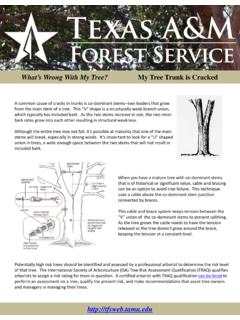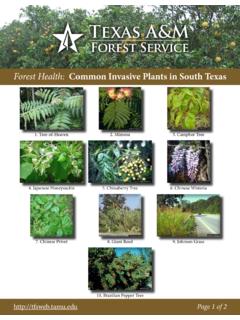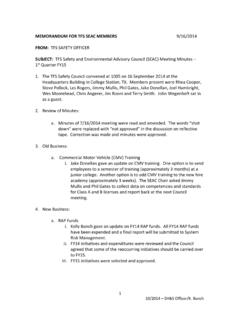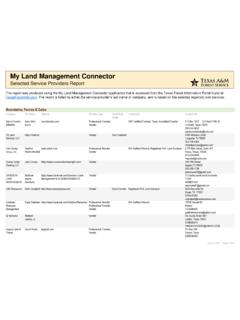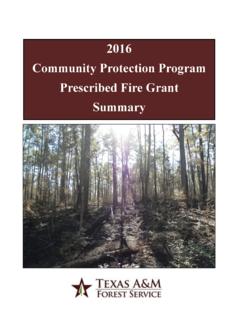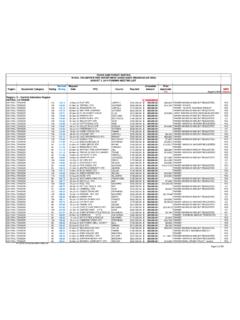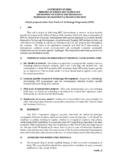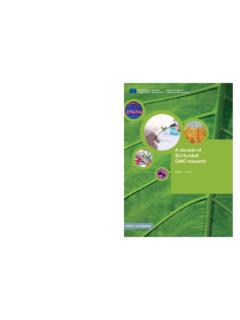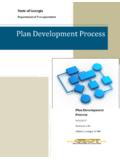Transcription of Melanie Karns - texasforestservice.tamu.edu
1 This letter serves to announce the State-Wide Community Wildfire Protection Plan Grant Program for Texas A&M Forest Service (TFS). The purpose of this grant program is to encourage the development of Community Wildfire Protection Plans (CWPP) and mitigation projects for fuels reduction. These funds are being provided through a grant from the Forest Service and is subject to the provisions contained in 2 CFR 200, Uniform Administrative Requirements, Cost Principles, and Audit Requirements for Federal Awards ( ). Planning for wildfires must take place long before a community is threatened. Once a wildfire starts, the only option available to firefighters is to attempt to suppress the fire before it reaches a community.
2 A CWPP is unique in that it empowers citizens to share the responsibility of determining the best strategies for protecting a community and allows making informed choices to decrease the hazards around them. Eligible CWPP grant applicants are local county or community governments in the State of Texas who have been identified by TFS for funding based on the intent to develop a new CWPP or update an existing CWPP. Private or non-profit organizations are not eligible for grant funds. There are two stages to the application process. First, an applicant should complete the application and submit it to: Texas A&M Forest Service Mitigation & Prevention Office Attn. CWPP Coordinator 2127 S.
3 First Street Lufkin, TX 75901 Second, the application is reviewed by the grant committee for eligibility, feasibility, cost-effectiveness and completeness before returning their decision. Applicant will be notified of their status within thirty days of receipt of the application. Applications will be accepted until all funds have been awarded. Early applications are encouraged. Priority will be given to applications received prior to March 2, 2018. The grant cost period will begin upon notice from the CWPP Coordinator, Texas A&M Forest Service and end March 1, 2019 in conjunction with the completion of an approved CWPP. If you have any questions about the guidelines, application, or the funding available please do not hesitate to contact me at (979) 450-2578.
4 Regards, Melanie Karns Wildland Urban Interface Specialist III Texas A&M Forest Service Cell: 979-450-2578 Fax: 936-639-8110 State-Wide Community Wildfire Protection Plan Grant Program 2 | Page State-Wide Community Wildfire Protection Plan Grant Program Document Package Index Components of a CWPP Guidelines Procedures Application State-Wide Community Wildfire Protection Plan Grant Program 3 | Page Components of a CWPP A Community Wildfire Protection Plan (CWPP) is a written document that identifies the steps a community will take to reduce its risk of damage from a wildland fire. The plan addresses the community s wildland fire response capability, as well as the protection of homes and structures within the community.
5 The plan also should identify and prioritize areas of private, state and federal land where fuels treatment projects are necessary to reduce wildland fire threats to the community and its infrastructure. Finally, the CWPP should include details about how steps outlined in the plan will be implemented. Community Wildfire Protection Plans are generally developed by local government with assistance from state and federal agencies and other interested partners. Plans can take a variety of forms and may be as simple or complex as necessary, based on the specific needs and desires of the local community or county. While plans do not need to be overly complicated they should effectively address values-at -risk, priorities for action and local forest and range conditions.
6 The minimum requirements for a CWPP are: o Collaboration. A CWPP must be collaboratively developed. Local officials and state officials must meaningfully involve federal agencies that manage land in the vicinity of the community and other interested parties, particularly non-governmental stakeholders. o Prioritized Fuel Reduction. A CWPP must identify and prioritize areas for hazardous fuel reduction treatments on both federal and non-federal land and recommend the types and methods of treatment that, if completed, would reduce the risk to the community. o Treatment of Structural Ignitability. A CWPP must recommend measures that homeowners and communities can take to reduce the ignitability of structures throughout the area addressed by the plan.
7 The HFRA requires that three entities must mutually agree to the final contents of a CWPP: o The applicable local government ( counties or cities); o The local fire department(s); and o The state agency responsible for forest management. Benefits to the community include: o The opportunity to establish a locally appropriate definition and boundary for the WUI. o The requirement for federal agencies, when planning fuel reduction projects, to give priority to projects that provide for the protection of at-risk-communities or watersheds, or that implement recommendations in a CWPP. o Expedited National Environmental Policy Act (NEPA) procedures for federal agencies implementing fuel reduction projects identified in a CWPP.
8 (If a federal agency is planning a fuels reduction project to implement a recommendation in a CWPP that lies within the WUI and is located no further than 1 miles from the community boundary, the federal agency does not need to analyze any other alternatives under NEPA.) When allocating federal funds for fuel reduction projects on nonfederal lands, federal and state agencies should, to the maximum extent applicable, give priority to communities that have adopted Community Wildfire Protection Plans. State-Wide Community Wildfire Protection Plan Grant Program 4 | Page State-Wide Community Wildfire Protection Plan Grant Program General Guidelines 1. Grant funds will be awarded to local county or community governments using a competitive matrix, based on the intent to develop a new CWPP or update an existing CWPP and Communities at Risk as determined by the Texas Wildfire Risk Assessment Portal (TxWRAP).
9 2. Minimum requirements of a CWPP: a. Form a core working group made up of representatives from the appropriate local governments, local fire authority, law enforcement, federal partners and the Texas A&M Forest Service b. Contact and involve other land management agencies as appropriate c. Contact and encourage active involvement in plan development from a broad range of interested organizations and stakeholders d. Work with partners to establish a baseline map of the community that defines the community s WUI and displays inhabited areas at risk, forested area that contain critical human infrastructure and forested areas at risk for large-scale fire disturbance e. Work with partners to develop community risk assessments for each Community at Risk, as identified by TxWRAP, that considers fuel hazards; risk of wildfire occurrence; homes, businesses, and essential infrastructure at risk; other community values at risk; and local preparedness capability (TFS shall provide assessment templates) f.
10 Rate the level of risk for each factor and incorporate into the base map as appropriate g. Use the base map and community risk assessments to facilitate at least three collaborative community discussions that lead to the identification of local priorities for fuel treatment, reducing structure ignitability, and other issues of interest such as improving fire response capability h. Clearly indicate whether priority projects are directly related to protection of communities and essential infrastructure or to reducing wildfire risk to other community values i. Develop a detailed implementation strategy to accompany the CWPP. Include a tracking sheet of all stakeholder meetings, which indicates date and topic of the meeting j.
